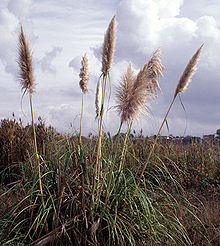- Cortaderia jubata
-
Cortaderia jubata
Andean pampas grass
Scientific classification Kingdom: Plantae (unranked): Angiosperms (unranked): Monocots (unranked): Commelinids Order: Poales Family: Poaceae Genus: Cortaderia Species: C. jubata Binomial name Cortaderia jubata
(Lem.) StapfSynonyms Cortaderia atacamensis
Cortaderia jubata is a species of grass known by several common names, including Purple pampas grass and Andean pampas grass. It is similar to its more widespread relative, the Pampas Grass C. selloana, but it can get quite a bit taller, approaching seven meters in height at maximum.
This grass is native to the northern Andes but it is well-known elsewhere as an invasive species noxious weed. This grass has only pistillate parts, that is, all individuals are female. It reproduces by apomixis, in which embryos develop without fertilization.
Description
This pampas grass, Cortaderia jubata, has long, thin, razor-edged leaves forming a large bunch grass tussock from which the eye-catching inflorescences arise. At the top of a stem several meters in height is an inflorescence of plumelike spikelets. These panicles are pink or purplish when new and they gradually turn cream or white. Each inflorescence is packed full of fruits which develop despite the plant's having never been fertilized. Each plant produces millions of seeds per year. They disperse easily by several methods, including wind, water, and soil transport.
Invasive species
New Zealand
In New Zealand C. jubata is listed on the National Pest Plant Accord prohibiting it from sale, and commercial propagation and distribution.[1]
United States
Cortaderia jubata grows well in the conditions provided by the cool, moist California coast, where it was presumably an introduced species as an attractive ornamental plant.[citation needed] It is a common weed of Redwood National and State Parks, the Central Coast region, and Big Sur, as well as other coastal hillsides and roadsides throughout the state. The plant competes with native vegetation, interferes with the natural scenery of the unique ecosystems and habitats (ie: Redwood and Coastal sage scrub), harbors pest species such as rats, and produces large amounts of dry foliage which is a wildfire hazard.
References
- ^ "National Pest Plant Accord 2008". 2008. http://www.biosecurity.govt.nz/files/pests/plants/nppa/nppa-accord-manual.pdf. Retrieved 2009-01-26.
External links
Categories:- Cortaderia
- Flora of Peru
- Flora of Bolivia
- Flora of Chile
- Flora of South America
- Invasive plant species
- Invasive plant species in the United States
- Invasive plant species in California
- Invasive plant species in Oregon
Wikimedia Foundation. 2010.
